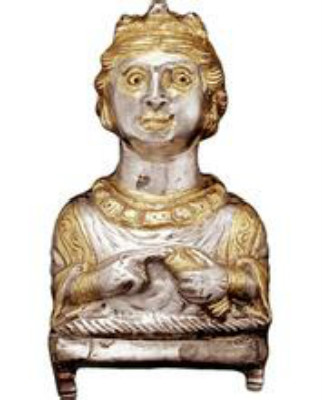Of course there were other ports on the Red Sea and other countries sending ships to India. The actual value of the trade was enormous-one hint we have of this is from a second-century papyrus known as the Muziris papyrus. And in that they discuss the cost of a shipload-and it is estimated today at seven million sestertia. Just to put that in context, at that same time a soldier in the Roman army would have earned about 800 sestertia a year."
當然,在紅海別的港口以及別的國家也都有開往印度的船只,貿易金額巨大,一份穆集里斯的莎草紙文獻記載,整船的胡椒價值700萬賽斯特帖姆,而當時羅馬士兵一年的薪俸僅為800賽斯特帖姆。
So regularly filling a large silver pepper pot like ours would have taken its toll on the grocery bills. And the household that owned our pepper pot had another three silver pots, for pepper or other spice-one shaped as Hercules in action, and two in the shape of animals. This is dizzying extravagance, the stuff of bankers' bonuses. But the pepper pots are just a tiny part of the great hoard of buried treasure-they were found in a chest containing 78 spoons, 20 ladles, 29 pieces of spectacular gold jewellery-and over 15,000 gold and silver coins. Fifteen different emperors are represented on the coins-the latest is Constantine III, who came to power in 407, and it is this that helps us to date the hoard. It must have been buried for safekeeping sometime after that year-a time when Roman authority in Britain was rapidly breaking down.
因此,讓本節中的這個胡椒罐保持常滿狀態必然會花去大筆開支,但胡麵的主人還擁有3個類似的銀罐,其中一個的外形是希臘神話中 的英雄赫拉克勒斯,另兩件則是動物造型,用來盛放胡椒或其他香料,簡直奢侈得驚人。盡管如此,胡椒瓶也只是這批埋藏的寶藏中的一小部分。 當時出土的一個柜子里有78把普通湯匙,20把長柄勺,29件 金飾,以及一萬五千多枚金銀幣。硬幣上共有十五位君主的肖像,距今最近的一位是公元407年登基的康斯坦丁三世。由此我們推斷,這批寶藏的大致埋藏時期一定在此之后。差不多就在此時,羅馬帝國在英國的統治迅速崩塌。
來源:可可英語 http://www.ccdyzl.cn/Article/201503/361722.shtml











